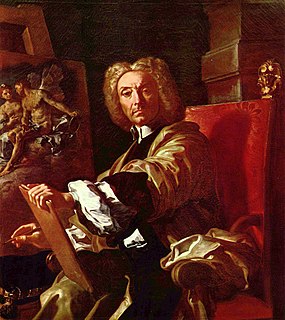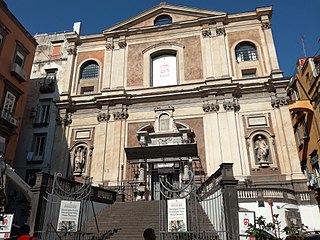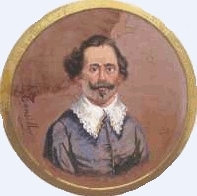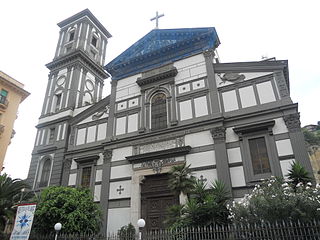Related Research Articles

The House of Orsini is an Italian noble family that was one of the most influential princely families in medieval Italy and Renaissance Rome. Members of the Orsini family include five popes: Stephen II (752-757), Paul I (757-767), Celestine III (1191–1198), Nicholas III (1277–1280), and Benedict XIII (1724–1730). In addition, the family included 34 cardinals, numerous condottieri, and other significant political and religious figures.

Luca Giordano was an Italian late-Baroque painter and printmaker in etching. Fluent and decorative, he worked successfully in Naples and Rome, Florence, and Venice, before spending a decade in Spain.

Santa Maria sopra Minerva is one of the major churches of the Roman Catholic Order of Preachers in Rome, Italy. The church's name derives from the fact that the first Christian church structure on the site was built directly over the ruins or foundations of a temple dedicated to the Egyptian goddess Isis, which had been erroneously ascribed to the Greco-Roman goddess Minerva.

Francesco Solimena was a prolific Italian painter of the Baroque era, one of an established family of painters and draughtsmen.

Francesco Laurana, also known as Francesco de la Vrana was a Dalmatian sculptor and medallist. He is considered both a Croatian and an Italian sculptor. Though born in the territory of the Republic of Venice, he spent his mature career at the other end of Italy, moving between Naples and Sicily, and Urbino, and finally in southern France, where he died.
Sersale is a comune in the province of Catanzaro in the Calabria region of Italy. As of 2013, Sersale had an estimated population of 4,701. Sersale was founded in 1620. It was named after a baron named Francesco Sersale who owned a large amount of land in the area surrounding the present borders of Sersale. Francesco Sersale and his family came from Naples. There are records of this family in that area from as far back as 1271.

The Naples Cathedral, or Cathedral of the Assumption of Mary, is a Roman Catholic cathedral, the main church of Naples, southern Italy, and the seat of the Archbishop of Naples. It is widely known as the Cattedrale di San Gennaro, in honour of the city's patron saint.

Santa Maria Donnregina Nuova is a church in central Naples, Italy. It is called Nuova ("new") to distinguish it from the older Angevin church of Santa Maria Donna Regina Vecchia.

Santa Maria la Nova is a Renaissance style, now-deconsecrated, Roman Catholic church and monastery in central Naples. The church is located at the beginning of a side street directly across from the east side of the main post office, a few blocks south of the Church and Monastery of Santa Chiara. Today the adjacent monastery is a meeting site and hosts the Museo ARCA of modern religious art.

San Francesco di Paola is a prominent church located to the west in Piazza del Plebiscito, the main square of Naples, Italy.

San Giovanni a Carbonara is a Gothic church in Naples, Southern Italy. It is located at the northern end of via Carbonara, just outside what used to be the eastern wall of the old city. The name carbonara was given to this site allocated for the collection and burning of refuse outside the city walls in the Middle Ages.

Sant'Anna dei Lombardi,, and also known as Santa Maria di Monte Oliveto, is an ancient church and convent located in piazza Monteoliveto in central Naples, Italy. Across Monteoliveto street from the Fountain in the square is the Renaissance palace of Orsini di Gravina.

The Italian Catholic Diocese of San Marco Argentano-Scalea, in Cosenza, Calabria, has existed as the diocese of San Marco since at least 1171, when the name of Bishop Ruben appears in a document. It is now a suffragan of the Archdiocese of Cosenza-Bisignano.

Giuseppe Aprile was an Italian castrato singer and music teacher. He was also known as 'Sciroletto' or 'Scirolino'.
The Italian Catholic diocese of Castellammare di Stabia, on the Bay of Naples, existed until 1986. In that year it became part of the archdiocese of Sorrento-Castellammare di Stabia.

Luigi Tansillo (1510–1568) was an Italian poet of the Petrarchian school. Born in Venosa, he entered the service of Pedro Álvarez de Toledo in 1536 and in 1540 entered the Accademia degli Umidi, soon renamed Accademia Fiorentina.

Christianity and religion in general has always been an important part of the social and cultural life of Naples. It is the seat of the Archdiocese of Naples, and the Catholic faith is highly important to the people of Naples and there are hundreds of historic churches in the city. The Cathedral of Naples is the most important place of worship in the city, each year on September 19 it hosts the Miracle of Saint Januarius, the city's patron saint. In the miracle which thousands of Neapolitans flock to witness, the dried blood of Januarius is said to turn to liquid when brought close to relics said to be of his body: this is one of the most important traditions for Neapolitans.

Santa Maria di Piedigrotta is a Baroque-style church in Naples, Italy; it is located in the neighborhood or quartiere of Piedigrotta.

Santa Maria delle Grazie Maggiore a Caponapoli or Santa Maria delle Grazie Maggiore is a church located in the historic center of Naples, Italy.

Michelangelo Naccherino was an Italian sculptor and architect, active mainly in the Kingdom of Naples, Italy.
References
- ↑ Ascher, Yoni (2000). "Tommaso Malvito and Neapolitan Tomb Design of the Early Cinquecento". Journal of the Warburg and Courtauld Institutes. 63: 111–130. doi:10.2307/751523. JSTOR 751523. S2CID 193411071.
- ↑ Filangieri, G (1883–91). "Documenti per la storia, le arti e le industrie delle provincie napoletane". 1: 474.
{{cite journal}}: Cite journal requires|journal=(help)